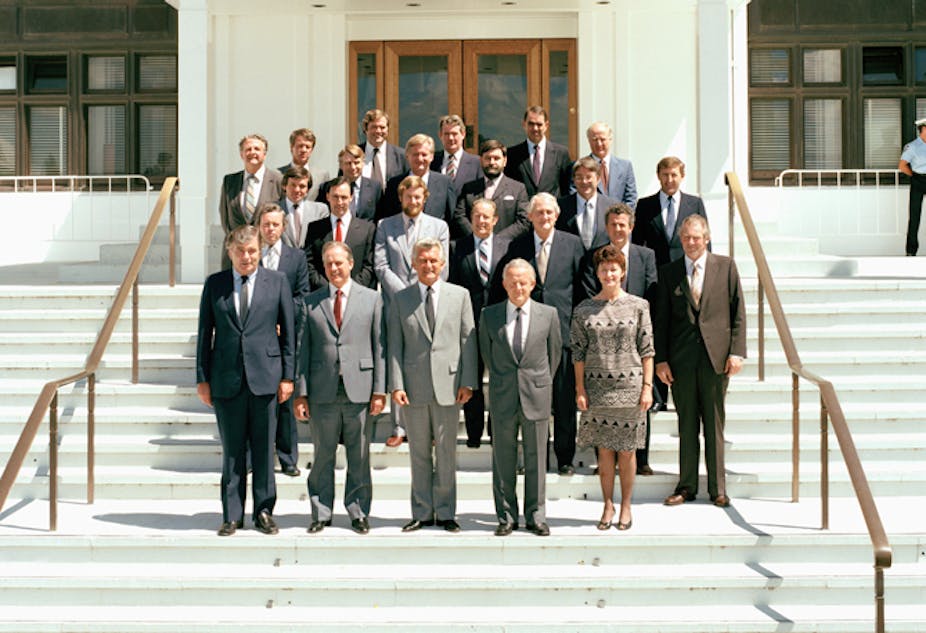The release of the 1988-89 cabinet documents show that the Hawke government’s plans for Australian higher education were in some ways as radical as the policies that Education Minister Christopher Pyne floated in 2014. What we pay for higher education and how the HECS system works came close to being very different.
Then-education minister John Dawkins oversaw some of the biggest changes to higher education in Australia, including the introduction of HECS in 1989. This was at a time when the Hawke government had already gently shocked the country with a series of major economic reforms which changed Australia, including floating the Australian dollar.
One of the most dramatic changes during John Dawkins’ short few years as education minister was turning Australia’s other institutions of higher education at the time – the Colleges of Advanced Education – into universities. This changed who taught in universities, who undertook research, and ultimately who was allowed to attend, as the system quickly expanded to include new students, teachers and researchers. In doing this he took an elite education system and turned it into a mass education system.
To fund this expansion in student numbers, Dawkins finalised the move away from Whitlam’s policy of no tuition fees for students by creating the Higher Education Contribution Scheme. A scheme now universally known as HECS.
Australians had become more used to the market driving much that government did, but as the cabinet documents reveal, higher education may have meant a different world for many Australian students.
Some of what could have become higher education policy then is being debated now. There has been a strong reaction against the government’s proposal earlier this year – since dropped – that HECS be subjected to a real interest rate. The cabinet documents now show this was a live option in the design of the original HECS. The Department of Finance supported:
… a suitable real interest rate be applied to outstanding debts.
HECS may never have been implemented at all
In 1988, former NSW premier Neville Wran handed down a report on options for higher education financing. This examined, among others options, the world-first policy that was to become HECS. In assessing the findings of Wran’s report, a caucus consultative group was appointed to help guide options for the major government decision on how to pay for an expanded higher education system.
The powerful cross-factional caucus group looked at a number of options: direct student contributions through HECS, a levy on business, higher taxes for high-income earners and greater funding from general government revenue. All supported the idea that business should pay something towards the graduates they were employing (one recommendation never directly implemented).
But there was serious disagreement. A couple of working group members did not agree with the HECS proposal at all. In the end, the group came to recommend that HECS be supported while unanimously rejecting the push for a real interest rate. A uniform per year charge was also recommended for all students, irrespective of field of study. The group was worried that any attempt to match course cost to teaching costs in different courses might be disincentive to study in:
… relatively high cost courses in areas of national priority (eg science and engineering).
Unfortunately for many students in high-cost disciplines and those that are thought to offer high-wage potential, the policy of a uniform charge was overturned by subsequent education ministers, with students now paying different amounts for different courses.
Dawkins finally had cabinet agree on a HECS system where debts were indexed at consumer price index (CPI), as is still the case for HECS loans.
It is interesting to note in the current debate over “debt sentences”, the original projections included in the cabinet documents the anticipated time that it would take students to pay back their debt – albeit at a lower repayment requirement than is anticipated should the Pyne changes go through. The cost of most degrees were expected to take a decade or longer to repay. Some, like teachers, were expected to be burdened for at least 16 years. The current average time to repay across the board is about ten years.
It is also worth reflecting that the original cabinet minutes recorded the fact that there was almost never a University of Canberra. Cabinet had agreed that the ANU should merge with the School of Music and the Canberra College of Advanced Education, the latter of which was to become University of Canberra. Given University of Canberra Vice Chancellor Stephen Parker has been a vocal opponent of Pyne’s proposed changes, you have to wonder whether the present government has days when it wishes the merger had gone ahead.

